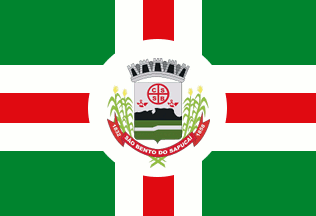 image by
Dirk Schönberger,
2 February 2013
image by
Dirk Schönberger,
2 February 2013Based on: http://pt.wikipedia.org/wiki/S%E3o_Bento_do_Sapuca%25C3%25AD

Last modified: 2013-03-16 by ian macdonald
Keywords: sao paulo | são bento do sapucaí |
Links: FOTW homepage |
search |
disclaimer and copyright |
write us |
mirrors
 image by
Dirk Schönberger,
2 February 2013
image by
Dirk Schönberger,
2 February 2013
Based on:
http://pt.wikipedia.org/wiki/S%E3o_Bento_do_Sapuca%25C3%25AD
A red upright cross bordered white on a green field with the municipal arms on a white disk on the cross.
Official website at
http://www.saobentodosapucai.sp.gov.br
Dirk Schönberger,
2 February 2013
São Bento do Sapucaí was founded by pioneers from Taubaté who headed to the gold deposits of Minas Gerais via the Sapucaí Valley. Gaspar Vaz da Cunha, aka Oyaguara, was one of the first settlers of the valley. He was followed by cattle farmers, including Rio de Janeiro-born José Pereira Alves, who came from Pindamonhangaba to found anew settlement. José Pereira Alves invited Father Júlio Velho Columbreiro, from Pindamonhangaba, to erect a cross and a banner dedicated to the Blessed Virgin. Father José Bento de Melo, Vicar of Pouso Alegre, upset by this unofficial act, uprooted the cross and the banner and jailed Columbreiro. Pereira did not give up; together with this wife Ignez Leite de Toledo, he offered a big piece of land to erect a chapel dedicated to St. Benedict.
The flag, designed by Antônio Peixoto de Faria, is green with a white- red-white cross. In the middle of the flag is placed the municipal coat of arms inscribed in a white disk. The municipal circle is a symbol of eternity, being a geometrical figure without either a beginning or a end. White is a symbol of peace, friendship, work, prosperity, purity and religious feeling. Red is a symbol of dedication, patriotic love, intrepidity, courage and valiance. Green is a symbol of honour, civility, abundance, joy and hope.
http://www.valedoparaiba.com/cidadesdaregiao/?pagina=cidade&cidade=São%20Bento%20do%20Sapuca%C3%AD&menu=956 - "Enciclopédia VP" website
The coat of arms is made of a Samnitic shield, the first style of shield introduced from France to Portugal and inherited by Brazilian heraldry, evokes the colonizers and main builders of the Brazilian nationality. The mural crown is a symbol of municipal emancipation, representing here a second-rank town, seat of a "comarca" Argent is a symbol of peace, friendship, work, prosperity, purity and religious feeling. The chief features the emblem of the Order of Saint Benedict* (São Bento), making the arms canting and recalling the town's patron saint and namesake. Gules is a symbol of dedication, patriotic love, intrepidity, courage and valiance. The two hunting horns surrounding the emblem in base represent one of the main sources of income for the municipality. The base vert represents the valley in which the town emerged; the fess wavy argent represents river Sapucaí. The rocks sable represents Pedra do Baú**, a significant geographic feature of the municipality. Vert is a symbol of honour, civility, courtesy, abundance and joy. It is also the symbol of hope, like the greening fields in spring promising profuse harvests. Sable is a symbol of austerity, prudence, knowledge, moderation and strong-mindedness. Rice and maize are the main crops produced by the generous and fertile soil. Beneath the shield, a scroll gules is inscribed with the municipality's name, surrounded by the years "1832" (establishment of the parish) and "1858" (municipal emancipation", all argent.
http://www.valedoparaiba.com/cidadesdaregiao/?pagina=cidade&cidade=São%20Bento%20do%20Sapuca%C3%AD&menu=957 - "Enciclopédia VP" website
*This is, indeed, the back side of the medal of Saint Benedict. The cross is charged with the letters "CSSML" ("Crux sacra sit mihi lux!" - May the holy cross be my light!) on the vertical arm and "NDSM" ("Non draco sit mihi dux!" - May the dragon never be my overlord!) on the horizontal arm, the "S" shared by the two words being placed in the intersection of the cross' arms. The cross is cantoned by the letters "C", "S", "P", and "B" ("Crux Sancti Patris Benedicti" - The Cross of [our] Holy Father Benedict). The border of the medal is charged with the letters "V R S N S M V - S M Q L I V B" ("Vade retro Satana! Nunquam suade mihi vana! Sunt mala quae libas. Ipse venena bibas!" - Begone Satan! Never tempt me with your vanities! What you offer me is evil. Drink the poison yourself!), to be read clockwise. PAX (Peace), placed at the top of the medal, is replaced on the flag by the Christogramm "IHS".
http://www.newadvent.org/cathen/13338a.htm - "Catholic Encyclopaedia"
**http://commons.wikimedia.org/wiki/File:Pedra_do_Bau.JPG - Photo
Ivan Sache, 12 February 2013